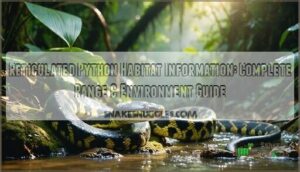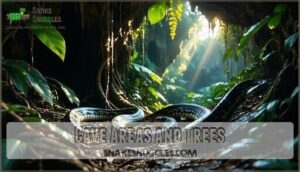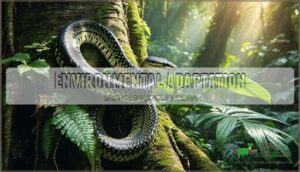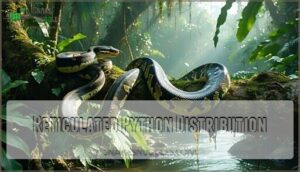This site is supported by our readers. We may earn a commission, at no cost to you, if you purchase through links.

These massive constrictors prefer hot, humid environments near water sources like rivers, swamps, and lakes where they can showcase their impressive swimming skills.
While they’re most at home in dense rainforests and wetlands, don’t be surprised to spot them in grasslands, agricultural areas, or even urban outskirts—they’re remarkably adaptable.
These ambush predators need consistent warmth, moisture, and access to prey, making tropical climates perfect for their needs.
Their habitat versatility explains why they’ve become one of the world’s most successful large snake species, thriving in environments that provide the necessary conditions for their survival.
Table Of Contents
- Key Takeaways
- Reticulated Python Habitat
- Geographic Range
- Habitat Characteristics
- Environmental Adaptation
- Habitat Factors
- Reticulated Python Distribution
- Frequently Asked Questions (FAQs)
- What size enclosure does a reticulated python need?
- What are some interesting facts about the reticulated python?
- Are reticulated pythons aggressive?
- How often should I feed reticulated python?
- How do reticulated pythons survive seasonal droughts?
- What predators threaten adult reticulated pythons?
- Do reticulated pythons hibernate during cold months?
- How do pollution levels affect python habitats?
- What diseases commonly affect wild python populations?
- Conclusion
Key Takeaways
- You’ll find reticulated pythons thriving across Southeast Asia’s tropical regions, from Indonesia and Bangladesh to the Philippines, where they’ve adapted to diverse environments including rainforests, wetlands, grasslands, and even urban areas.
- These massive constrictors require hot, humid conditions between 75-93°F with high moisture levels (60-80% humidity) and consistent access to water sources like rivers, swamps, and lakes for drinking, temperature regulation, and hunting.
- You’ll discover they’re remarkably adaptable predators that excel at both swimming and climbing, using these abilities to colonize remote islands and exploit various habitats from dense forest canopies to city drainage systems.
- Their habitat success depends on abundant prey availability (rodents, birds, mammals), adequate shelter options like caves and trees, and minimal human interference, though habitat loss and urban encroachment increasingly threaten their natural territories.
Reticulated Python Habitat
You’ll find reticulated pythons thriving in Southeast Asia’s tropical forests, from Bangladesh to the Philippines, where they’ve mastered life in both wild and urban environments.
These adaptable giants require warm, humid conditions near water sources, making rainforests, wetlands, and even city sewers their perfect homes.
Tropical Forest Regions
You’ll discover reticulated pythons thriving throughout tropical forest regions where dense forest canopy and complex understory ecology create perfect hunting grounds.
These massive serpents navigate seamlessly between ground level and treetops, adapting remarkably well despite tropical deforestation and biodiversity impacts.
Python habitat conservation efforts focus on protecting remaining forests, as python distribution depends heavily on intact tropical forest ecosystems across Southeast Asia.
Southeast Asia Distribution
You’ll find reticulated pythons spread across Southeast Asia’s vast tropical landscapes, from Bangladesh to the Philippines.
These massive serpents navigate Southeast Asia’s islands with remarkable ease, swimming between tropical paradises from Bangladesh to the Philippines.
Their python distribution spans multiple countries, creating diverse populations adapted to local conditions. This widespread range contributes to significant genetic variation among populations.
Key Southeast Asian countries hosting reticulated python populations:
- Indonesia – Home to the largest populations across numerous islands
- Philippines – Multiple island populations showing island endemism patterns
- Malaysia and Thailand – Mainland populations in tropical forest regions
- Vietnam and Myanmar – Eastern and western range boundaries respectively
Human encroachment and habitat fragmentation increasingly threaten these python habitat areas, making conservation efforts critical for maintaining healthy populations across this extensive Southeast Asian range.
Urban Adaptation
You’ll spot reticulated pythons thriving in bustling cities across Southeast Asia, where urban adaptation has become their secret weapon.
These resourceful serpents transform sewer habitats into highways, using drainage systems to navigate metropolitan areas undetected.
Their adaptation strategies include raiding urban gardens and stalking pets in residential neighborhoods.
City survival depends on exploiting abundant prey like rats and stray cats, making pet predation a concern.
Human interaction increases as pythons venture into populated zones, making it a growing concern for urban dwellers.
Water Body Proximity
You’ll find reticulated pythons never stray far from water sources, as these massive constrictors depend on rivers, streams, and swamps for survival.
Their swimming prowess enables island colonization across Southeast Asia’s archipelagos, while floodplain habitats provide ideal hunting grounds.
Key water-related adaptations include:
- Aquatic hunting – Ambushing prey near drinking sources and waterways
- Swamp adaptation – Thriving in wetland environments with consistent moisture
- Swimming ability – Crossing between islands and traversing flooded areas
Geographic Range
You’ll find reticulated pythons spread across a vast geographic range that stretches from South and Southeast Asia to several introduced populations worldwide.
Their natural territory spans from western Bangladesh and India all the way to the Philippines and Indonesia’s Greater Sunda Islands, with some populations reaching elevations over 4,300 feet in mountainous regions.
Southeast Asia Countries
You’ll encounter Malayopython reticulatus across twelve Southeast Asian countries, from Bangladesh’s western borders to the Philippines’ eastern archipelago.
This species thrives throughout Myanmar, Thailand, Laos, Cambodia, Vietnam, Malaysia, Singapore, and Indonesia’s vast island chains.
| Country | Primary Habitat | Conservation Status |
|---|---|---|
| Indonesia | Rainforests, plantations | Declining populations |
| Philippines | Island forests, mangroves | Regional variations noted |
| Malaysia | Wetlands, urban areas | Human encroachment concerns |
| Thailand | Rivers, agricultural zones | Python trade regulations |
Southeast Asian wildlife benefits from this python’s adaptability to tropical ecology conditions; similar to rattlesnakes, they occupy diverse habitats, which is a key factor in their survival and conservation status. The python trade regulations and human encroachment concerns are also crucial aspects to consider when discussing the Malayopython reticulatus.
Introduced Populations
Escaping captivity through the pet trade, reticulated pythons have established invasive populations in Florida and other regions outside their native range.
These Florida populations create significant ecological consequences, prompting extensive python removal and eradication efforts.
Despite ongoing python population control measures, these invasive species continue expanding their range, threatening native wildlife and disrupting established ecosystems throughout affected areas.
Elevation Range
You’ll encounter reticulated pythons from sea level up to remarkable elevations exceeding 4,300 feet in some regions.
Their altitude adaptation allows colonization of diverse tropical rainforests, where prey distribution and climate impact remain favorable.
However, habitat limits exist as physiological effects from extreme elevation changes affect their ability to regulate temperature and moisture requirements effectively.
Temperature Preferences
Beyond altitude variations, you’ll find reticulated pythons thrive in consistently warm temperatures between 75-93°F (24-34°C).
Their python temperature needs remain fairly stable year-round in tropical climates, though python enclosure setups require careful thermal regulation.
- Optimal Range: Python environment temperatures of 80-88°F support active hunting and digestion
- Temperature Gradient: Wild pythons seek cooler spots during peak heat, warmer areas when needed
- Python Humidity: High moisture levels (70-80%) complement their temperature preferences perfectly
- Seasonal Variation: Minimal temperature changes in native tropical habitats maintain consistent behavior
- Geographic Differences: Island populations show slight adaptations to local climate variations
Climate change increasingly affects their traditional temperature zones.
Habitat Characteristics
You’ll find reticulated pythons thriving in diverse habitats that share key environmental features essential for their survival.
These massive serpents require specific conditions including proximity to water sources, adequate shelter options, and temperature ranges that support their cold-blooded metabolism, which is a key factor in their cold-blooded lifestyle.
Rainforests and Wetlands
You’ll find reticulated pythons thriving in tropical rainforests and wetlands throughout Southeast Asia, where dense forest canopy provides perfect hunting grounds and swamp ecology supports abundant prey.
These waterbodies create ideal conditions with consistent moisture and seasonal flooding patterns.
However, habitat degradation threatens these environments, making habitat preservation essential for maintaining healthy populations where prey abundance naturally sustains these magnificent serpents.
Grassland Forests
Within tropical grassland forests, you’ll discover prime reticulated python habitat where seasonal changes create dynamic ecosystems.
These environments offer excellent prey abundance during wet seasons when grassland biodiversity peaks.
Forest fires naturally maintain these habitats, preventing complete forest closure, and conservation efforts focus on preserving these intermediate zones where grasslands meet forested areas.
As habitat preservation guarantees continued forest ecology balance essential for python survival, and efforts made will safeguard this delicate balance, it is crucial for maintaining the ecosystem’s health and ensuring the python survival.
Cave Areas and Trees
You’ll discover reticulated pythons utilizing caves and trees as essential shelter throughout their range.
Cave microclimates provide stable temperatures between 24-34°C, perfect for digestion after feeding. Juveniles display impressive climbing adaptations, spending considerable time in the forest canopy hunting arboreal prey.
Adults occasionally use vertical habitat for thermoregulation despite their size. Habitat destruction threatens these important refuges, making habitat protection essential for python survival.
They’re a non-venomous constrictor that kills prey by squeezing.
Water Source Requirements
You’ll need consistent access to fresh water for your reticulated python’s survival and hunting success.
These massive snakes depend heavily on aquatic environments for hydration, temperature regulation, and prey capture in their tropical climate habitat.
Essential Water Requirements:
- Hydration Frequency – Daily access to clean drinking water
- Water Quality – Fresh, chlorine-free sources prevent health issues
- Humidity Levels – 60-80% moisture maintains proper python environment
- Aquatic Prey – Water bodies attract fish, birds, and mammals for hunting
Water temperature should match their python habitat preferences, staying between 75-85°F.
To guarantee adequate humidity, consider using cypress mulch substrate to help retain moisture.
In python care, maintaining proper humidity levels mimics their natural tropical climate conditions where they thrive near rivers and wetlands.
Environmental Adaptation
You’ll find that reticulated pythons demonstrate remarkable environmental flexibility, thriving in diverse habitats from dense rainforests to bustling urban centers.
Their exceptional swimming and climbing abilities allow them to exploit both aquatic and arboreal niches while adapting to human-modified landscapes with surprising success.
Hot and Humid Environments
You’ll find reticulated pythons thriving in tropical climates where humidity levels stay consistently high.
These snakes require warm temperatures between 24°C and 34°C, making monsoon seasons particularly favorable for their activity.
Coastal habitats provide ideal conditions with dense vegetation that retains moisture.
Python habitat preferences clearly favor environments where thermal regulation becomes easier through abundant humidity.
Climate influence shapes their distribution patterns substantially.
Swimming and Climbing Abilities
Through powerful muscular strength, reticulated pythons excel at both arboreal and aquatic locomotion, making them versatile predators.
Their excellent swimmer abilities enable island colonization across Southeast Asia, while strong coils support arboreal adaptations for tree climbing.
These movement techniques facilitate aquatic hunting in rivers and streams.
Supplying a proper habitat may require specialized snake products.
Python behavior demonstrates remarkable environmental flexibility, as their snake environment demands diverse locomotion skills for survival across varied terrains, showcasing their ability to thrive in different environments with proper habitat.
Habitat Versatility
Reticulated pythons showcase remarkable adaptation examples across diverse environments, from tropical rainforest canopies to urban sewers.
Their behavioral shifts and survival strategies enable colonization of varied habitats including caves, grasslands, and woodlands.
This flexibility influences their dietary choices and contributes to their invasive success when introduced to new regions, making proper habitat setup essential for captive specimens.
Urban and Agricultural Areas
You’ll find these snakes thriving in cities and farms across Southeast Asia, where urbanization and agriculture have created new opportunities.
Urban food sources like rats and pets attract pythons to metropolitan areas, while agricultural settings provide abundant rodents from crop cultivation.
Key adaptation patterns include:
- Urban infrastructure use – pythons utilize drainage systems and abandoned buildings for shelter
- Agricultural ecosystem integration – rice paddies and plantations offer hunting grounds and water access
- Human-wildlife conflict management – python relocation programs address safety concerns in populated areas
- Pet escape populations – introduced individuals establish breeding populations in suitable climates.
Wildlife management agencies report increasing encounters in these modified habitats, requiring specialized protocols for human safety and python conservation.
Habitat Factors
When you’re studying reticulated pythons, you’ll discover that several critical habitat factors determine where these massive snakes can successfully establish populations.
These environmental conditions directly influence their survival, reproduction rates, and overall distribution patterns across their native and introduced ranges, which is a key aspect of understanding the distribution of these species.
Food Availability
Understanding food availability helps you appreciate how reticulated pythons thrive across diverse environments.
These adaptable predators capitalize on prey abundance in their chosen habitats, adjusting their python diet based on seasonal changes and local ecosystems.
Their hunting success depends heavily on rodents, birds, and mammals present in each area.
| Habitat Type | Primary Prey Available |
|---|---|
| Tropical Forests | Birds, mammals, reptiles, bats |
| Urban Areas | Rodents, cats, dogs, chickens |
| Wetlands | Water birds, small mammals, fish |
Diet variations reflect predator-prey dynamics, with urban prey becoming increasingly important as pythons adapt to human-modified landscapes.
Food availability directly influences where these snakes establish territories and hunting patterns.
Space and Mobility
You’ll need adequate territory size since these pythons roam extensively through their natural habitats, requiring substantial enclosure needs for captive specimens.
Their movement patterns involve both terrestrial and arboreal behaviors, demanding constriction space for hunting and climbing opportunities for exercise.
- Territory Size: Wild pythons cover several kilometers of territory
- Movement Patterns: Use serpentine locomotion across varied terrain
- Constriction Space: Need room to fully extend when capturing prey
- Enclosure Needs: Minimum 8×4 feet for adult python size requirements
- Climbing Habits: Require vertical space with proper python substrate and python lighting
Temperature and Moisture
Tropical temperatures between 24-34°C drive thermoregulation in reticulated pythons, who bask to maintain ideal ranges.
Humidity levels must stay high year-round, though seasonal variation affects microclimate selection. You’ll find them seeking python substrate that retains moisture while providing thermal gradients.
Many owners purchase suitable substrate options for their python habitats.
Their python size demands extensive basking areas, and proper python lighting becomes vital during incubation periods when females coil protectively around eggs for their entire python lifespan, which involves thermal gradients and requires suitable python substrate.
Human-Induced Habitat Changes
Deforestation impacts and urban sprawl dramatically reshape reticulated python territories across Southeast Asia.
Agricultural expansion eliminates vast forest corridors, while pollution effects contaminate essential water sources these serpents depend on.
Key human-induced changes affecting python habitats:
- Forest conversion – Over 30% habitat loss since 1973 fragments populations
- Infrastructure development – Roads increase mortality rates by 4% annually
- Harvesting pressure – 400,000+ pythons removed yearly for trade
These alterations force behavioral adaptations, with pythons increasingly utilizing rice paddies and drainage systems as substitute habitats.
Suburban snakes similarly adapt by exploiting artificial structures for shelter.
Reticulated Python Distribution
You’ll find reticulated pythons spread across a remarkable range that spans from India to the Philippines, with their native territory covering most of Southeast Asia’s tropical regions.
These adaptable giants have also established themselves in places like southern Florida and northern Australia, thanks to their impressive ability to swim between islands and colonize new territories.
Native Range
Across southeastern Asia’s tropical landscapes, reticulated pythons call an impressive geographic range their home.
Their natural range spans from western Bangladesh through Myanmar, Thailand, Laos, Cambodia, and Vietnam, extending south through Malaysia, Singapore, Indonesia, and the Philippines.
These Asian Origins showcase remarkable genetic diversity across Indo-Pacific islands, where island endemism has created distinct populations.
Unfortunately, habitat loss threatens many areas within their range, though range expansion continues on smaller islands due to their excellent swimming abilities.
These factors contribute to the complex dynamics of reticulated python populations, highlighting the need for conservation efforts to protect their natural range.
Introduced Range
While reticulated pythons naturally belong in Southeast Asia, you’ll find established populations beyond their native range due to human activity.
The pet trade has inadvertently created invasive species challenges in several regions, raising concerns about python environmental impact and species distribution patterns.
Here’s where introduced populations have taken hold:
- Florida populations – thriving in the Everglades after pet releases
- Australian sightings – documented in northern Queensland and Northern Territory
- Sudan introduction – established presence in eastern regions
- Pet trade consequences – ongoing python invasive species management needed
- Python ecology disruption – affecting local wildlife and ecosystems.
These introductions highlight the importance of python habitat protection in native ranges while managing invasive populations elsewhere.
Island Colonization
You’ll find these pythons are natural island hoppers, using their exceptional swimming ability for island dispersal across Southeast Asian archipelagos.
Their sea-crossing talents enable colonization of remote locations like the Nicobar and Mentawai Islands, where founder effect and genetic drift shape unique populations.
Resource availability determines successful establishment, creating distinct island ecology patterns that demonstrate remarkable adaptation across their geographic distribution and species distribution range.
They’re known to be excellent ambush hunters, waiting for prey to come within striking distance, showcasing their exceptional swimming ability and ability to be natural island hoppers with a strong ambush hunters instinct.
Population Density and Habitat Preferences
Tracking python numbers proves tricky, but researchers observe higher urban density near water sources where prey abundance peaks.
Island population studies reveal pythons establish colonies through impressive swimming abilities, creating habitat competition with native species.
Geographic distribution patterns show seasonal migration toward flood-prone areas during breeding cycles.
Environmental conditions like temperature and humidity directly influence ecosystem roles, with ideal habitat setup supporting roughly one python per square kilometer in prime rainforest locations.
Frequently Asked Questions (FAQs)
What size enclosure does a reticulated python need?
You’ll need an enormous enclosure for adult reticulated pythons – at least 8x4x4 feet minimum, though bigger is always better for these massive snakes.
What are some interesting facts about the reticulated python?
You’ll be amazed that these pythons can reach 32 feet long.
They’re the world’s longest snakes, excellent swimmers who’ve colonized remote islands.
Their intricate diamond patterns make them living works of art.
Are reticulated pythons aggressive?
Reticulated pythons aren’t naturally aggressive toward humans.
They’re typically shy, preferring to avoid confrontation.
However, they’ll defend themselves when threatened or cornered, potentially delivering painful bites with their numerous sharp teeth, which can be very painful.
How often should I feed reticulated python?
You’ll feed juveniles weekly and adults every 1-2 weeks.
Young snakes under three need more frequent meals, while mature pythons can go longer between feedings since their growth slows down substantially.
How do reticulated pythons survive seasonal droughts?
You’ll find these pythons adapt by seeking water-rich refuges like caves, dense vegetation, or urban water sources during dry seasons, slowing their metabolism to conserve energy.
What predators threaten adult reticulated pythons?
Imagine a massive crocodile lunging from murky water at a 20-foot python.
You’ll find that crocodiles pose the primary threat to adult reticulated pythons, especially near water where these ambush predators strike.
Do reticulated pythons hibernate during cold months?
No, you won’t see reticulated pythons hibernating during cold months.
These tropical snakes need warm temperatures between 75-93°F year-round, so they’d simply become inactive or die in truly cold weather rather than hibernate.
How do pollution levels affect python habitats?
Pollution degrades python habitats through contaminated water sources and heavy metal accumulation, disrupting food chains while causing health problems that reduce lifespans and increase predation risks.
What diseases commonly affect wild python populations?
Wild pythons face several serious threats.
You’ll find snake fungal disease caused by Ophidiomyces ophiodiicola affecting numerous species, while nidoviruses cause severe respiratory disease, especially in pythons.
Lung parasites like Raillietiella orientalis spread through invasive populations, which is another significant threat to wild pythons, in addition to nidoviruses.
Conclusion
Understanding reticulated python habitat information becomes essential when you’re exploring these serpentine giants’ environmental needs.
You’ve discovered how these adaptable constrictors flourish across Southeast Asia’s diverse landscapes, from pristine rainforests to bustling urban fringes.
Their remarkable habitat versatility—thriving in wetlands, grasslands, and agricultural zones—demonstrates nature’s incredible adaptability.
Whether you’re researching for conservation efforts or satisfying curiosity, you now appreciate how temperature, moisture, and prey availability shape their distribution patterns across tropical regions.

















